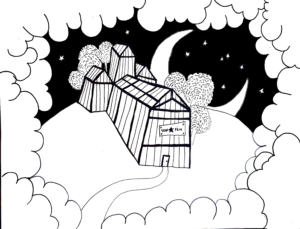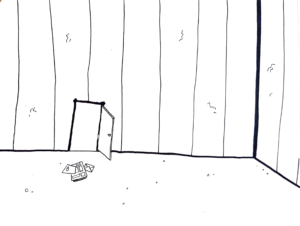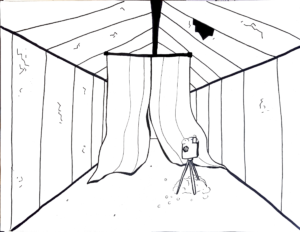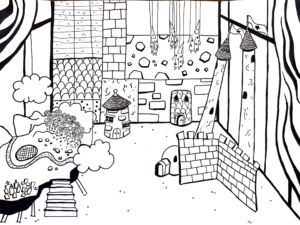Hi everyone,
While making our little Méliès game, we stumbled upon an issue : we didn’t know how to create an investigation puzzle ! Pretty big issue for a team who is supposed to create a detective game, right ?
On the course of our development, we therefore decided to start game jaming between us in order to see what ideas we could find individually, and how we could pick the best of each proposal for our game. But we didn’t want to start right on with Unity ; no, we wanted to keep it simple, to go fast and aim for efficiency. So we decided to start with paper, with a strong belief that if we were able to create an investigation puzzle that would be fun that way, it would be all the way more enjoyable once built in a game. Today, I will be presenting the first investigation puzzle I created, which ended up being partly used for our final prototype.
This puzzle has been designed to test some of our game’s core mechanisms on paper. It requires a good deal of guidance from the tester, as not all of the game’s mechanics and interactive features are explained to the player. Yet, it offers an experience relatively close to the one we’re aiming for.
The character can move around the two spaces indicated as the studio. This is the physical space, in Montreuil in 1929, in which Georgette evolves, in search of her father. At any given moment, she can screen – thanks to the cinematograph – three scenes, corresponding to the three papers drawn in black and white. On her way in the studio, she comes across letters, books, notes and all sorts of preparatory visual documents that have been left behind in the different rooms. These provide a reservoir of clues, but are not the entirety of the clues that can be found in the game, as these are also to be found in the studio setting itself – which act as a sort of witness of the making of the film the player is investigating – as well as in the scenes that they investigate. These scenes are partially solved here: two have already been completed. The player can therefore rely on what he sees on the screen as a solid basis of clues, but also on the scripts of these scenes, which reveal other clues, missing from the image.
In this exercise, therefore, there is only one scene to complete, whose script is not yet known. Three elements are missing and will have to be inlaid. The player, moving around the studio between two rooms, can choose at any time to shoot an element of his choice, and attach it into the incomplete scene. Even if, by its nature as a rather rough paper prototype, the puzzle requires a companion to be fully understood, you can try to take the time and figure it out for yourself and stop your reading here for a while!
CLUES
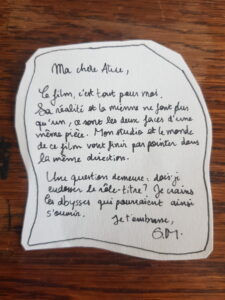
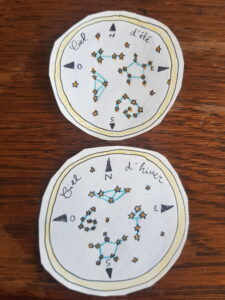
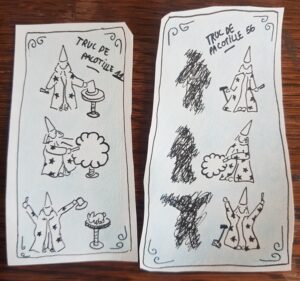
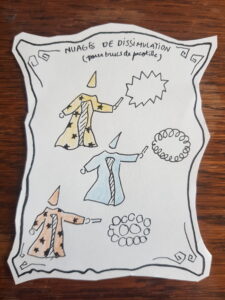
PLACE THAT YOU CAN EXPLORE IN THE STUDIO
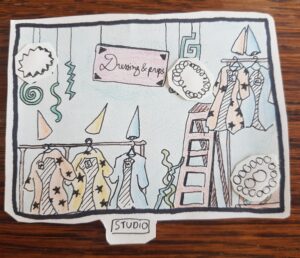

SCENES ALREADY FILLED
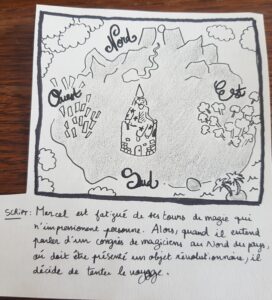

SCENE TO BE COMPLETED
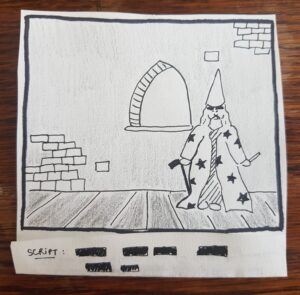
*SPOILERS BELOW*
Generally speaking, this scene takes place before the other two. Marcel the magician is performing a cheap trick, which you’ll need to understand. The idea of this scene revolves around a rather crude trick. As we can see from the two clues describing 2 tricks in detail, the central element of the trick – the prestige, if you like – is a cloud of concealment. This can conceal a magician’s hat, as in the first trick, but it can also conceal a lever, as in this trick. The first element to be inlaid is therefore a cloud of concealment.
The question is which one, since a clue tells us that there are three kinds of these! This exercise is a purely mathematical deduction, and can be taken in several directions, each leading to the same result. By observing Marcel in the scene to be completed, we see two large eyebrows. By cross-checking with the actors considered for this role, we understand that one of the actors can be discarded. The two remaining actors are either M or XL. A quick look in the dressing room reveals that the only XL magician’s dress has no stars: the actor chosen to play Marcel must therefore be Georges Méliès. The dress is therefore orange, which informs us by cross-referencing with the cloud index of the cloud to be attached (the one formed by circles).
Next to Marcel is a large void. As far as a movie frame is concerned, that’s something of an issue… In one of the clues to the junk towers, we see that a shadow is supposed to come to life when Marcel secretly moves the lever. Walking around the set, the lever can be seen connected to three ropes by a mechanism that hangs over the stage. Nearby, two puppets with exactly the same three attachments are laying. One of them must therefore be inserted into the scene…
Here, the resolution mechanic required of the player is to understand the chronology of the scenes, and to make use of it. In the congress scene, Marcel dreams of dumping his old puppet. The puppet at stake is hidden by the garbage bin in which it is placed, but you can still see its feet sticking out: they’re square. So you have to shoot the puppet with square feet and add it to the scene.
Finally, the last puzzle requires us to understand something deeper about the game universe: as a letter from Melies indicates, something happened in the making of this film, that brought together two very distinct spaces: the one of the film, and the of the studio. There are several aspects to this rapprochement, the first of which is quite simply geographical. Reality and fiction have merged, until their spaces become indistinguishable. Here, the set that the player is investigating is lying against the studio canopy. Outside, the stars are visible. Snow is falling, it must be winter. Using the sky charts and the arrow-shaped constellation we can identify, we can conclude that the direction facing us in the studio is East. Since the two worlds are merging, we can conclude that the direction facing us in the incomplete scene is also East. Therefore, through the window of the magician, we should see what is at his East ! Thanks to the map we see in one of the completed scenes, the East is full of trees. In the studio, matte paintings have been prepared to be inlaid on the film’s windows, so we need to film the one with lots of trees.
SCENE COMPLETED
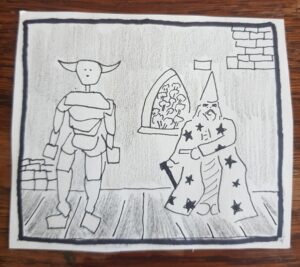
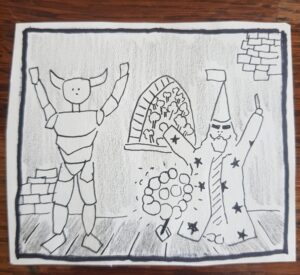
Thibault
